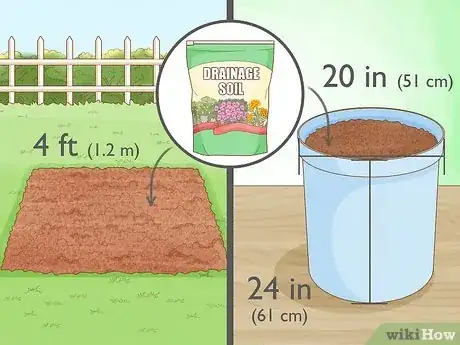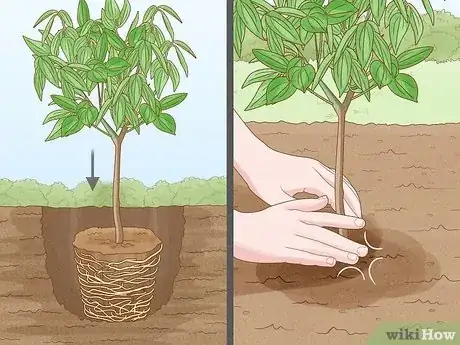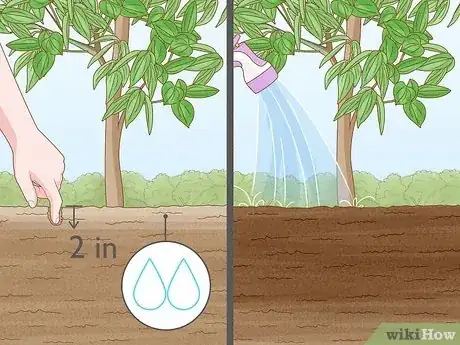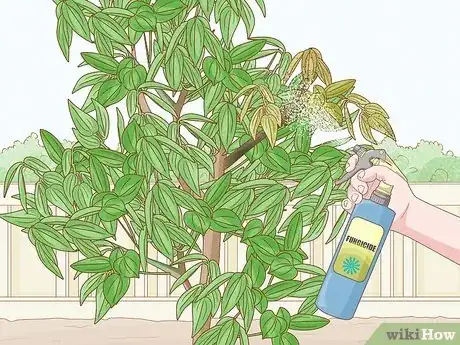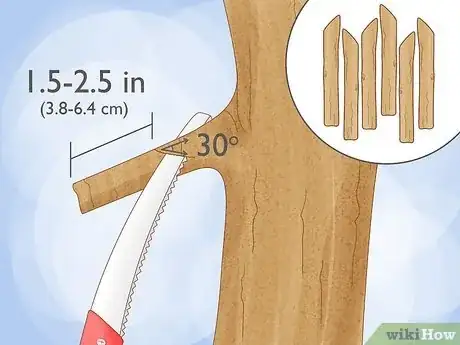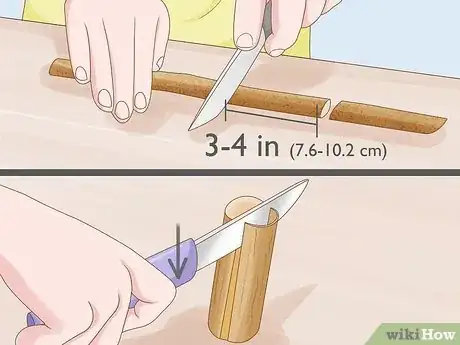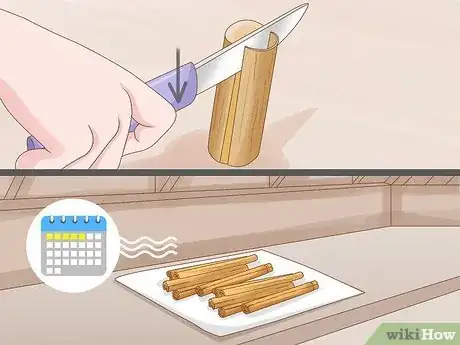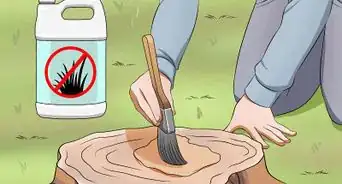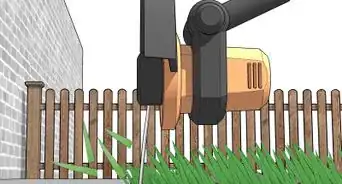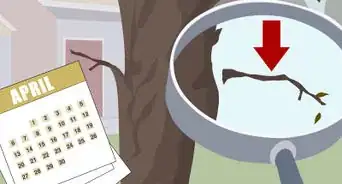X
This article was co-authored by Maggie Moran. Maggie Moran is a Professional Gardener in Pennsylvania.
This article has been viewed 92,258 times.
Cinnamon is a popular spice commonly used in baking. It comes in both powder and stick form, both of which actually come from the bark of the tree. Growing your own cinnamon is easy, and the bark will be ready for harvest within a couple of years. While you can always harvest the seeds yourself, you can save yourself some time and effort but purchasing a young tree from a nursery.
Steps
Part 1
Part 1 of 4:
Ensuring the Right Conditions
-
1Decide if you want to plant the tree indoors or outdoors. Cinnamon trees will do well in either location, as long as they receive around full sun. If the temperatures in your area fall below 68 °F (20 °C), then it might be best to plant the cinnamon indoors.[1]
- You don't have to keep a potted cinnamon indoors year-round. You can keep it outside and bring it in only when the temperatures drop below 68 °F (20 °C).
-
2Choose a location that receives 12 hours of sunlight every day. Full sun is a must for cinnamon, so some place that receives around 12 hours of full sunlight each day would be ideal.[2] If this is an indoor tree, a south-facing window would be ideal because the sunlight would be stronger.
- If you are keeping the tree indoors and live in the southern hemisphere, a north-facing window would be better.
Advertisement -
3Buy some well-draining soil from a nursery. Do not use soil from the garden, as it may contain harmful bacteria that may contaminate your tree. If the soil isn't labeled as "well-draining," ensure that it contains soil, sand, and perlite. This particular combination will allow the soil to drain well.[3]
- For an outdoor tree, you need enough soil to fill a 4 ft (1.2 m) square area.
- For an indoor tree, you need enough to fill a 24 by 20 in (61 by 51 cm) pot.
-
4Ensure that the soil's pH is between 4.5 and 5.5. Cinnamon loves acidic soil, so this pH range is a must. Purchase a pH testing kit from a nursery, then use it to test the soil's pH[4]
Advertisement
Part 2
Part 2 of 4:
Planting the Cinnamon
-
1Buy a cinnamon tree from a nursery or harvest the seeds yourself. Whether you buy a young tree or harvest the seeds is up to you. If you choose to harvest the seeds, wait until the berries turn black first, then split them open. Set them out to dry in the shade for 2 to 3 days, then separate and rinse the seeds. Allow them to dry in the shade once more.[7]
- Harvest the seeds from strong, healthy cinnamon trees with smooth, easily-peeling bark and a high oil content. Plan to use the seeds within 7 to 10 days.
- You may be able to purchase fresh cinnamon seeds online, but you need to plant them as soon as possible.
-
2Fill a 4 ft (1.2 m) square area with your soil. Use a shovel to dig a plot that's at least 4 by 4 feet (120 by 120 cm) and 12 inches (30 cm) deep. Fill the plot with your acidic, well-draining soil. For an indoor tree, use a glazed, 24 by 20 in (61 by 51 cm) ceramic pot with drainage holes instead.
- Cover the holes in your pot with window screening before you add the soil. This will prevent the soil from falling out.
-
3Dig a 12 in (30 cm) hole for your tree. Use a gardening trowel to create a hole that’s 12 inches (30 cm) deep and 12 inches (30 cm) wide. If you are planting a seed, then use your finger or a stick to make a 1⁄2 in (1.3 cm) deep hole instead.[8]
- You can plant multiple seeds in 1 pot because you'll be thinning them out later. Keep the holes about 1 to 2 inches (2.5 to 5.1 cm) apart.
- You can only plant 1 tree per 1 4 ft (1.2 m).
-
4Set the tree into the hole, then tamp the soil down. Remove the tree from the flimsy pot that it came in first, then gently loosen the root ball. Set the tree into the hole, then fill the gaps in with more soil. Gently pat the soil down with your hands.
- If you are starting with seeds, place 1 seed into each hole, then brush soil over the hole.
-
5Water the soil. Use enough water to make the soil damp. If you planted your tree in a pot, then keep watering it until the water starts to come out of the drainage hole(s) at the bottom. After this initial watering, you don't need to water the tree again until the top 2 inches (5.1 cm) are dry.
- Don’t use tap water since it is often treated with chemicals.
-
6Thin the seedlings once they emerge. Wait until the seedlings form their first set of true leaves; they will be larger and darker than the other leaves. Next, choose the strongest, healthiest-looking seedling, and pluck out the rest. You can discard the plucked seedlings or transplant them into separate pots.
- If you started with a young tree, then you don’t need to worry about thinning it out.
Advertisement
Part 3
Part 3 of 4:
Caring for the Cinnamon
-
1Wait until the top 2 inches (5.1 cm) are dry before watering the tree. Depending on how hot and sunny it is, you may end up watering as seldom as once per week to as often as every single day.
- Once the tree have matured, after about 3 years, you only need to water it during droughts. This is because the roots have grown deep enough to reach the damp soil.
- Test the soil's moisture by sticking your finger into it. If the soil feels dry, it's time to water.
-
2Apply a time-release fertilizer between late winter and early fall. Choose a 8-3-9 or 10-10-10 time-release fertilizer, and apply it in a 20 in (51 cm) radius around the base of the tree. Drag a gardening fork through the fertilizer to mix it into the soil. Do this once or twice each week, starting in late winter and finishing in the fall.
- You can also use an organic fertilizer made from rotted manure and plants.[9]
- Read the instructions that came with your fertilizer to find out exactly when, how much, and how often you should use it. Each brand will be different.
- Once the tree matures after 2 to 3 years, you should use twice as much fertilizer.
-
3Keep a clear 10 to 12 in (25 to 30 cm) radius around tree. This includes things like mulch, grass, weeds, and other ground coverings. All of these things can harbor pests that can harm your tree. To prevent this, keep a 10 to 12 in (25 to 30 cm) radius around the base of the trunk free of any mulch or vegetation.[10]
- Vegetation includes things like grass and weeds.
- Remove the weeds 3 to 4 times per year for the first 2 years. After that, you only need to remove the weeds 1 or 2 times per year.
-
4Treat diseased areas with fungicides or remove them. Removing the diseased area is the safest, surest method. In some cases, such as with blight or gray leaf spot, you may be able to use fungicides. In more extreme cases, such as stripe cankers, you'll have to remove the diseased portion.[11]
- Watch out for: blight (gray leaf spot), brown root, pink disease, and stripe canker.
- Don't toss the diseased bark and stems into the compost bin or you'll contaminate it. You need to destroy them.
- Disinfect your tools afterwards with rubbing alcohol or a solution of 1 part bleach and 9 parts water.
-
5Eliminate pests with herbicides. Insecticides are not very effective because they don't kill the eggs. If you don't kill the eggs, then they will hatch, and you'll have to deal with the pests all over again.[12]
- Common cinnamon pests include: borers, caterpillars, jumping plant louse, leaf miners, and mites.
- Be sure to peel back the bark and treat the area underneath it. This is where all the eggs tend to be. When in doubt, treat the entire stem.
Advertisement
Part 4
Part 4 of 4:
Harvesting the Bark
-
1Wait until the tree is 2 years old before you harvest it. You do not need to prune the tree since the harvesting process will take care of that. You'll know when the tree is ready for harvesting when the bark turns brown and the leaves grow firm.
-
2Cut 4 to 6 stems to the ground between late spring and late summer. Choose 4 to 6 straight, healthy-looking stems, then use a fine-toothed saw to cut them down until they are 1.5 to 2.5 inches (3.8 to 6.4 cm) long. Make sure the cuts at 30-degree angles, slanting towards the middle/inside of the tree.[13]
- It would be even better to do so during the rainy season as the bark will be easier to peel away.
-
3Cut the shoots into shorter lengths, then score the bark. Something between 3 and 4 inches (7.6 and 10.2 cm) would be ideal. Use a sharp knife to slice the bark apart lengthwise (from top-to-bottom) on each mini shoot.[14]
- If the harvested stem was older, you may have to cut a little into the wood.
-
4Peel the bark off of the mini shoots, then set it out to dry. Use your fingers or a knife to pry the bark away from the wood. Once you have the bark peeled off, set it out in a shady area for about 4 to 5 days so that it can dry out.[15]
- The bark will start to curl up naturally on its own after you peel it. This is your cinnamon stick!
-
5Wait 2 years before harvesting the cinnamon again. Like many other spices, cinnamon can last a long time. This means that your original batch of harvested cinnamon should last you until the next harvest. You can harvest 4 to 6 stems every 2 years.[16]
- If this is an indoor tree, you can cut the stems shorter if they are growing too long. Left to itself, a cinnamon tree can grow up to 8 feet (2.4 m).
- Don’t harvest the same stems each time.
Advertisement
Expert Q&A
Did you know you can get expert answers for this article?
Unlock expert answers by supporting wikiHow
-
QuestionWhere do they grow cinnamon?
 Maggie MoranMaggie Moran is a Professional Gardener in Pennsylvania.
Maggie MoranMaggie Moran is a Professional Gardener in Pennsylvania.
Home & Garden Specialist
-
QuestionHow long does it take for a cinnamon tree to grow?
 Maggie MoranMaggie Moran is a Professional Gardener in Pennsylvania.
Maggie MoranMaggie Moran is a Professional Gardener in Pennsylvania.
Home & Garden Specialist
-
QuestionCan you grow a cinnamon tree indoors?
 Maggie MoranMaggie Moran is a Professional Gardener in Pennsylvania.
Maggie MoranMaggie Moran is a Professional Gardener in Pennsylvania.
Home & Garden Specialist
Advertisement
Things You'll Need
- Cinnamon sapling or seeds
- Well-grained soil (acidic)
- Gardening trowel
- Gardening fork
- 8-3-9 or 10-10-10 fertilizer
- Pruning shears
- Sharp knife
References
- ↑ https://www.herbazest.com/herb-garden/growing-cinnamon
- ↑ https://plantvillage.psu.edu/topics/cinnamon/infos/diseases_and_pests_description_uses_propagation
- ↑ https://plantvillage.psu.edu/topics/cinnamon/infos/diseases_and_pests_description_uses_propagation
- ↑ https://www.herbazest.com/herb-garden/growing-cinnamon
- ↑ https://hortnews.extension.iastate.edu/1994/4-6-1994/ph.html
- ↑ https://hortnews.extension.iastate.edu/1994/4-6-1994/ph.html
- ↑ https://www.herbazest.com/herb-garden/growing-cinnamon
- ↑ https://www.herbazest.com/herb-garden/growing-cinnamon
- ↑ https://www.herbazest.com/herb-garden/growing-cinnamon
- ↑ https://www.herbazest.com/herb-garden/growing-cinnamon
- ↑ https://www.herbazest.com/herb-garden/growing-cinnamon
- ↑ https://www.herbazest.com/herb-garden/growing-cinnamon
- ↑ https://www.herbazest.com/herb-garden/growing-cinnamon
- ↑ https://www.herbazest.com/herb-garden/growing-cinnamon
- ↑ https://www.herbazest.com/herb-garden/growing-cinnamon
- ↑ https://www.herbazest.com/herb-garden/growing-cinnamon
About This Article
Advertisement


